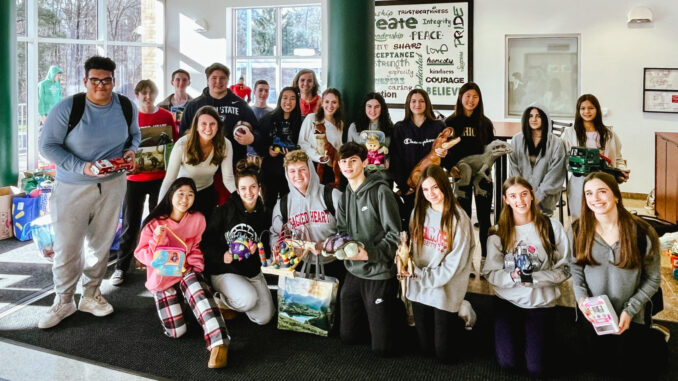
HILLSDALE—The Pascack Valley High School Environmental Club has joined for a ninth time with the non-profit organization Second Chance Toys “to keep used toys out of landfills and instead brighten the holidays of children in underserved areas of the state.”
This December, PVHS Environmental Club members donated more than 250 used toys to deserving children.
Each year, as the club tells Pascack Press, Second Chance Toys pairs Pascack Valley High School with a local homeless shelter, women’s shelter, or house of worship in an area of need. This year’s toys were donated to the Sayad Community Center in Newark.
“The benefits of our toy drive are twofold. We can bring some joy to local children while encouraging the recycling and reuse of toys that would otherwise have ended up in the garbage,” said Michela Piccoline, Environmental Club Advisor and PV Science Teacher.
Second Chance Toys (secondchancetoys.org) is a 501(c)3 nonprofit corporation founded in 2006 to rescue and recycle plastic toys for children in need by donating them to community organizations. It says on its website, “When you donate a much-needed and treasured toy, you are providing so much more than the toy itself.”
Here’s why, according to the nonprofit:
- Play is the “work” of young children. From earliest infancy on, toys provide the motivation and the medium for children to learn to control their bodies.
- Toys help children understand that their bodies are separate from objects, help them learn to reach and grasp, and provide a motivation to learn to roll, sit, crawl, stand, and walk.
- Through play with toys, children learn concepts of shape, weight, and size; by dropping and throwing toys, they also learn about gravity.
- The National Institute for Early Education Research suggests that without sufficient toys, children don’t develop necessary motor skills. Children learn to use language during play with toys. Studies also show that infant toys are critical for brain growth that affects learning later in life. Toys help prepare children for the academic learning that they will encounter when they enter formal school settings.
- Toys are also critical to children’s emotional development. According to Pamela Schachter, M.S. Ed., University of Medicine and Dentistry of New Jersey Early Intervention Program Manager, quoted on the nonprofit’s site,
- “Through toys, children learn that their actions have an impact on the world around them. Playing with a toy with another person encourages shared attention, mutual pleasure and is a child’s earliest ‘conversation’ with loving adults.”
- As children get older they learn about sharing, taking turns, and working collaboratively with others. Toys often serve as emotional security objects for young children, acting as a bridge for the security of a loving caregiver during times of separation.
- Toys provide opportunities for laughter, fun, and inquisitive exploration of the world. These are critical opportunities for the healthy development of children—emotionally, intellectually, and physically.
- In 2023, over 11 million children in the United States—6.9% of all children—are living in families with incomes below the federal poverty level: $27,750 a year for a family of four.
- Just by donating a gently used plastic toy, you can make a world of difference in the life of a disadvantaged child and at the same time help keep non biodegradable plastics out of our landfills.
Pascack Press most recently profiled the club when it hosted its Seventh Annual Halloween Costume Upcycle Drive at the Harvest Festival, held Oct. 20 at Meadowbrook Elementary School.
